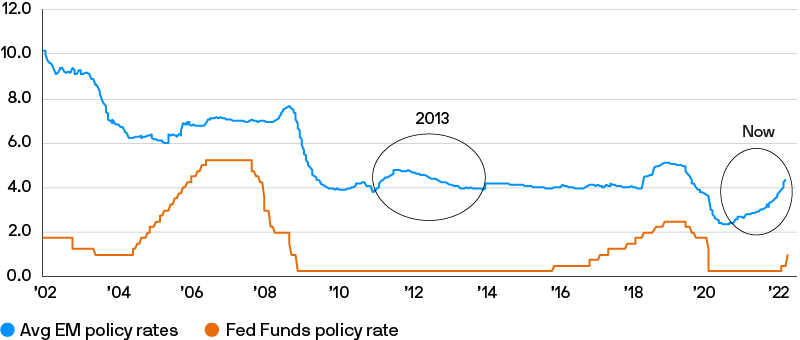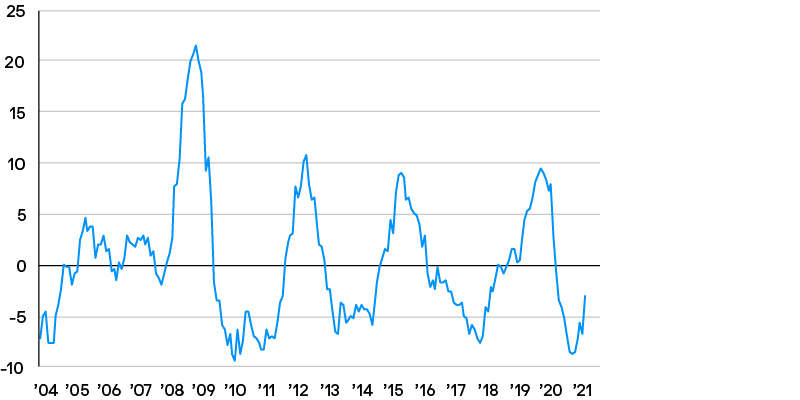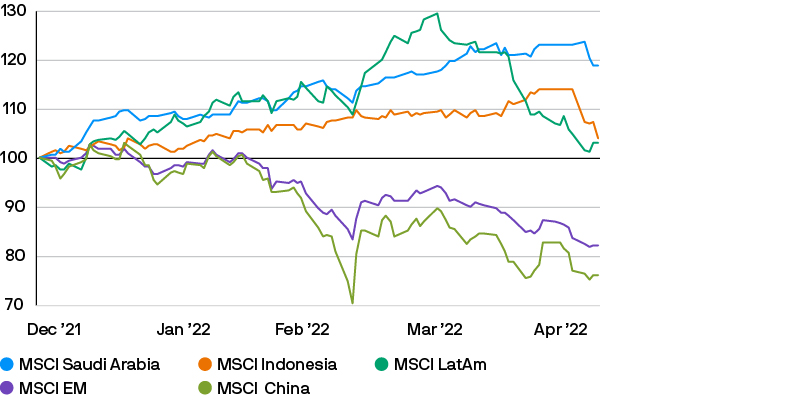What’s rattling emerging market equities and where they may go from here
Rate hikes, COVID-19 lockdowns and geopolitics have been punishing but we see potential silver linings
2022/05/16
Nandini Ramakrishnan
Anuj Arora
Rising interest rates are hurting growth stocks worldwide (value stocks have suffered less) at the same time concern is growing about the impact of China’s COVID-19 lockdowns on that important economy’s growth recovery. Meanwhile, the second order effects of the war in Ukraine have improved prospects for emerging market (EM) commodity producers. It’s a recipe for turbulence but even for the most punished indexes, we find reasons for optimism.
We’ll take these topics—rates, China and commodities—one by one.
While higher rates hurt EM stocks, the long-term growth story endures and strong companies should, too
Recent rate hikes and hawkish rhetoric from an inflation-fighting Federal Reserve (Fed) have battered high-growth stocks worldwide, spurring investors to rotate into value shares, which tend to outperform when rates and inflation are rising1. In China, the growth stock downturn began earlier (last summer, amid domestic regulatory changes). Declines then intensified across emerging market (EM) equities this year, and further in recent days. Growth stock valuations in EM, particularly China, are now back down to pre-pandemic levels, while value has held up a bit better.
Fed hikes are also challenging EM currencies and economies, not just equities. That is par for the course for a Fed hiking cycle that bolsters the USD. But compared to the last major monetary policy tightening cycle, in 2013, we think emerging markets today are in a much better position.
The U.S. dollar had already strengthened, in anticipation, when Fed hikes started this year (and it has appreciated significantly more in recent days). Further, the Fed in this cycle has generally been a pre-emptive and effective communicator. That makes us think U.S. dollar upside is likely limited, and that many EM currency markets may have already done a good portion of their FX adjustments.
Then there are the actions of EM central banks, which are doing the opposite of their 2013 predecessors. This time, they had already been raising rates when the Fed pivoted to a hawkish stance in December 2021 (Exhibit 1). This makes us optimistic that EM currencies, economies, and in turn EM equities, are in a much stronger place than they might be otherwise.
EM central banks have front-run Fed hikes, with rates up 250 basis points the past year
Exhibit 1: Average EM and DM central bank policy rates (2006–2022)

Source: Bloomberg, national central banks, J.P. Morgan Asset Management; data as of 12 May, 2022.
Where could EM equities go from here?
Recent turbulence has no impact on the long-term EM growth story, which we stand by firmly. Indeed, what seems to be an indiscriminate sell-off means good companies are more attractively valued than they have been in years. The team is discovering high conviction companies we believe will weather the storm, with earnings we expect will continue to grow.
Our emerging market Asia Pacific (EMAP) research team is also revisiting our long-term valuation assumptions, removing any exuberant P/E expectations, acknowledging that a years-long trend of across-the-board outperformance may not continue indefinitely.
Unleashing stimulus and relaxing “zero COVID” would unleash opportunities; stock selection may find unfairly punished stocks
China’s “zero COVID” policy has undeniably complicated a much-anticipated, stimulus-driven economic recovery. That’s the next crucial influence on EM equities.
Fiscal stimulus proved extremely powerful in China during the first pandemic year—so much so that officials engineered a slowdown, sapping growth (while various well-covered macroeconomic phenomena, from regulatory changes to property market issues arose in 2021). This left us optimistic that with valuations reset and growth being rekindled (at odds with developed market tightening), Chinese equities could prove a bright spot in 2022.
Then in March 2022, the omicron variant reared its head and the imposition of “zero-COVID” policy lockdowns led investors to question the likelihood that additional stimulus in China could spark a recovery. The Chinese government’s GDP growth for 2022 is 5.5%, however we expect a more modest 4% for the year.
Most importantly, we note that China’s credit impulse—monthly change in the flow of new credit—has turned upward (Exhibit 2). We consider it one of the keys to growth and one of the best indicators for China’s macro direction.
We believe China’s credit impulse can continue to rise, even as concerns about zero-COVID policy continue
Exhibit 2: China’s credit impulse (2004–2022)

Source: Bloomberg, J.P. Morgan Asset Management; data as of May 12, 2022.
Relaxation of the draconian pandemic policy is the other key to a growth recovery. A large part of Chinese equity markets have tended to track domestic macro growth, which though improving, is not booming yet. Policymakers are pushing for an economic recovery and we believe growth is in its early stages. The key downside risk is further tight COVID-19 policies. We acknowledge that China has no easy choices.
The impact on China’s equities
What’s our stock market outlook for China? Equities are undeniably attractive on a valuation basis. If China’s stimulus and economic recovery play out, we see real opportunity in Chinese equities, with the most battered sectors the most attractive, providing investors exercise great selectivity. The domestic market is geared towards an infrastructure and property market recovery, so it has potential upside when stimulus is delivered.
Volatility will likely persist in both the onshore and offshore parts of the market while global interest rates continue to rise and the pandemic lingers.
War in Ukraine creates upside for commodity producers’ equity markets
Russia’s war in Ukraine has had first- and second-order impacts. First, the immediate impact has been to remove Russia as an investable market. The second order impact—rising commodity prices globally—has been positive for a broad swathe of emerging markets.
Elevated commodity prices have helped EM producers’ equity indices make strong gains year-to-date, particularly Saudi Arabia, Indonesia and Latin America. (High prices have improved their current account balances, as well.) These countries’ equity indices have lost some steam in recent days, but remain much higher than China and other emerging markets, which was not the case before (Exhibit 3).
With commodities likely to be supported at elevated levels for some time, we expect upside for EM producers’ equity markets
Exhibit 3: MSCI EM winners and losers 2022 ytd

Source: Bloomberg; data as of May 12, 2022.
We have not been focused on many of these producers’ growth stories (as we have for China and India), in light of, among other concerns, certain environmental, social and governance issues. However, we think commodities may continue to supported at elevated levels over the next three to 12 months.
High prices imply upside for commodity producers in the equity market and, as their countries’ macroeconomic pictures improve, a boost to domestic demand that could strengthen corporate performance and feed through into equity markets, lengthening the upcycle. High commodity prices should also strengthen these countries’ FX, which, as noted, is particularly helpful in an environment of rising rates.
Investment implications
We see opportunities across the EM complex. Emerging markets have always been more volatile than developed markets, with a dynamic risk-return balance, and there’s no question it is one of those times. But long-term investors should see past the turbulence.
Over a reasonable investment period, we think the big picture economic and demographic growth story will prevail, with money to be made for those who keep focused on the long-term fundamentals.
1 For example, see Joyce Wang and Ian Butler, “Value vs. Growth investing: Value returns with a vengeance,” J.P. Morgan Asset Management, March 2022.
